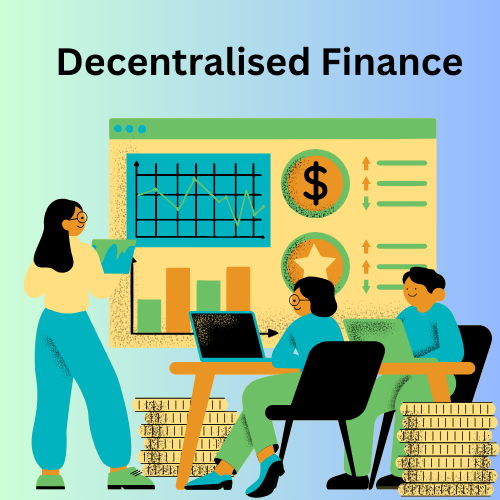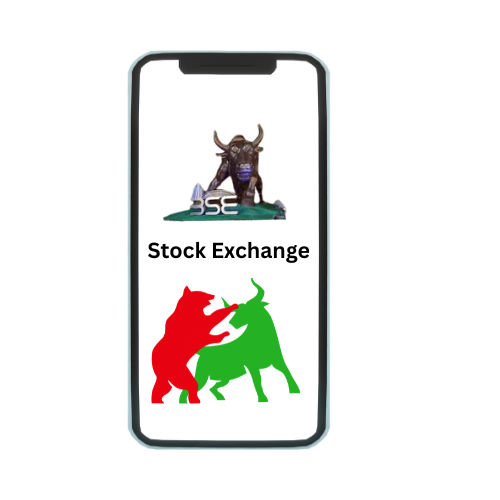Decentralized Finance (DeFi) is gradually gaining traction in India, driven by the increasing adoption of blockchain technology, the growth of cryptocurrency markets, and a young, tech-savvy population. Decentralized Finance (DeFi) refers to a financial ecosystem that operates on decentralized networks, primarily blockchain technology, to provide a wide range of financial services without traditional intermediaries like banks, brokers, or exchanges.

What is Decentralized Finance (DeFi)?
Decentralized Finance (DeFi) refers to a financial system that operates without traditional intermediaries such as banks, brokers, or exchanges, using blockchain technology to provide financial services directly between users. It aims to create an open-source, permission less, and transparent ecosystem where anyone can access financial services without relying on centralized authorities.
How Decentralized Finance Works??
Decentralized Finance (DeFi) works by utilizing blockchain technology and smart contracts to provide financial services without the need for traditional intermediaries such as banks, brokerages, or insurance companies. Here’s a breakdown of how DeFi works:
Key Components of How DeFi Works
- Blockchain Technology:
DeFi applications are built on blockchain networks, most commonly Ethereum, but also newer ones like Binance Smart Chain, Solana, and Polkadot. Transactions are recorded on a decentralized ledger (blockchain), where data is stored across multiple nodes (computers) in a network, ensuring transparency and security.
- Smart Contracts:
Smart contracts are self-executing agreements written in code. They automatically enforce the rules of the contract when pre-defined conditions are met, eliminating the need for human intermediaries. If a borrower provides collateral for a loan, a smart contract will automatically release the loan amount, and once the loan is repaid, it will return the collateral.
- DeFi Applications (DApps):
DeFi services operate through decentralized applications (DApps) that allow users to access various financial services. These DApps are built using smart contracts.
- Tokenization:
DeFi platforms use tokens to represent assets or provide access to services. For example, users may receive tokens for providing liquidity to a decentralized exchange or holding assets in a DeFi protocol. Most DeFi tokens follow the ERC-20 standard on Ethereum, making them interoperable across different DeFi protocols.
- Liquidity Pools:
DeFi platforms rely on liquidity pools, which are collections of funds supplied by users (liquidity providers). These pools are used in decentralized exchanges, lending, and yield farming to ensure liquidity for trades or loans. Liquidity providers earn rewards, often in the form of transaction fees or native platform tokens, for contributing to the pool.
- Interoperability and Composability:
DeFi platforms are designed to be interoperable, meaning that assets and services can be easily transferred and integrated between different protocols. This flexibility creates a more dynamic and versatile financial ecosystem. DeFi projects often refer to composability as “money Legos,” where different DeFi protocols can be stacked or combined to create new financial products and services.
Goals of Decentralized Finance
The goals of Decentralized Finance (DeFi) are rooted in transforming traditional financial systems by leveraging blockchain technology to create a more open, transparent, and accessible financial ecosystem. Here are the primary goals of DeFi:
- Financial Inclusion
Provide access to financial services for the unbanked and underbanked populations around the world. DeFi seeks to democratize finance by removing geographical, financial, and bureaucratic barriers, enabling anyone with an internet connection to access banking, lending, borrowing, and investing opportunities.
- Elimination of Intermediaries
Reduce reliance on traditional financial intermediaries like banks, brokers, and payment processors. By using blockchain and smart contracts, DeFi enables direct peer-to-peer transactions, reducing costs, speeding up transactions, and removing gatekeepers who control access to financial services.
- Transparency
Ensure all financial transactions are open and transparent. Since DeFi operates on public blockchain, every transaction and interaction is recorded and can be audited by anyone. This transparency helps build trust, reduces fraud, and enables users to understand how financial services operate.
- Programmability and Innovation
Enable the creation of programmable financial services and innovative new financial products. Smart contracts allow developers to create new forms of financial products (e.g., decentralized lending, insurance, and derivatives) that are automated, efficient, and interoperable across various platforms, promoting innovation in the financial space.
- Lower Costs and Increased Efficiency
Reduce fees and improve the efficiency of financial transactions. By automating transactions through smart contracts and eliminating intermediaries, DeFi reduces costs associated with traditional financial services, such as transaction fees, maintenance fees, and hidden charges.
- Control and Ownership
Give users full control over their assets and financial transactions. In DeFi, users hold custody of their funds through decentralized wallets, and smart contracts automatically execute agreements. This removes the need for trust in third parties, allowing users to have full autonomy over their financial decisions.
- Interoperability
Create a financial ecosystem where different decentralized applications (DApps) can work together seamlessly. DeFi protocols are designed to be interoperable, meaning they can interact and integrate with each other to offer users more flexibility and choice. This allows users to combine different services across multiple platforms, creating customized financial solutions.
- Censorship Resistance
Prevent central authorities from controlling or restricting access to financial services. Since DeFi operates on decentralized blockchain, no single entity (such as a government or financial institution) can censor or block access to financial services, ensuring that users have the freedom to transact as they wish.
- Access to Global Markets
Open up financial markets to anyone in the world, regardless of their location. DeFi platforms provide global access to financial products, allowing users to trade, invest, or lend without needing to be part of a specific national financial system. This creates opportunities for individuals in countries with limited financial infrastructure.
- Decentralized Governance
Create community-driven governance models for financial platforms. Many DeFi projects use decentralized governance, where users who hold the project’s tokens can vote on protocol changes, fee structures, and other key decisions. This shifts control from centralized institutions to the community of users.
What is an Example of Decentralized Finance?
Instadapp: A DeFi Platform
Instadapp is a decentralized application that acts as a middleware platform to help users manage their assets across multiple DeFi protocols like Compound, Aave, and Uniswap. Founded by two Indian brothers, Samyak and Sowmay Jain, Instadapp streamlines complex DeFi activities and makes it easier for users to interact with different DeFi protocols through a single interface.
Key Features:
- DeFi Aggregator: Instadapp aggregates various DeFi services into one platform, enabling users to access lending, borrowing, staking, and yield farming across multiple protocols without needing to interact with each one individually.
- Automation: The platform provides automation tools like debt refinancing and collateral management, making it easier for users to optimize their DeFi positions.
- Smart Accounts: Instadapp provides users with “smart accounts,” allowing them to interact with different DeFi protocols from one central hub. This helps users manage risk and maximize returns on their DeFi activities.
- Composability: The platform enables users to combine and build on different DeFi services, making it more accessible to both beginners and experienced DeFi participants.
User Experience:
- Instadapp simplifies DeFi interactions for users by abstracting away the complexities of individual DeFi protocols, allowing users to manage assets across protocols with ease, improving efficiency and user control.
Impact on the Indian Market:
- Instadapp represents India’s growing influence in the global DeFi ecosystem. It caters to both Indian and global audiences and highlights India’s technological prowess in building solutions for decentralized finance.
Other Emerging DeFi Projects
- WazirX DEX: While WazirX is primarily a centralized cryptocurrency exchange, it has begun incorporating decentralized features such as staking and DeFi liquidity pools, allowing users to earn rewards on their assets.
- Matic (Polygon): Though not solely focused on DeFi, the Polygon network (formerly Matic), co-founded by Indian developers, is heavily used for DeFi projects. It provides scalability to Ethereum-based DeFi applications, reducing costs and improving transaction speed.
Uses of Decentralized Finance
Decentralized Finance (DeFi) refers to a financial system built on blockchain technology that allows for peer-to-peer transactions without intermediaries like banks. Here are some key uses of DeFi:
- Lending and Borrowing: DeFi platforms enable users to lend their assets in exchange for interest or borrow assets by providing collateral. This can provide more accessible lending options and potentially better interest rates than traditional banks.
- Decentralized Exchanges (DEXs): DEXs facilitate trading of cryptocurrencies directly between users without the need for a centralized authority. They allow users to retain control of their funds, enhancing privacy and security.
- Yield Farming and Liquidity Mining: Users can earn rewards by providing liquidity to DeFi protocols. Yield farming involves staking or lending assets to generate returns, while liquidity mining offers tokens as incentives for users who supply liquidity.
- Stable coins: Many DeFi platforms use stable coins, which are cryptocurrencies pegged to traditional assets (like USD), providing a stable medium of exchange and a store of value within the DeFi ecosystem.
- Insurance: DeFi insurance protocols allow users to purchase coverage against specific risks (like smart contract failures or price drops) without relying on traditional insurance companies.
- Asset Management: DeFi platforms offer tools for automated investment strategies, allowing users to manage their assets with minimal intervention, often through smart contracts.
- Derivatives and Synthetic Assets: Users can trade derivatives and create synthetic assets that mimic the value of real-world assets, enabling exposure to various markets without directly holding the underlying assets.
- Governance: Many DeFi projects use decentralized governance models, allowing token holders to vote on protocol upgrades and changes, enhancing community involvement.
- Cross-Border Transactions: DeFi can facilitate low-cost and fast cross-border transactions, reducing the reliance on traditional remittance services.
- Financial Services for the Unbanked: DeFi can provide access to financial services for individuals who are unbanked or underbanked, offering opportunities to participate in the global economy.
DeFi Hype Stories
In India, the DeFi movement has started to gain traction, leading to various hype stories and developments that reflect both local and global trends. Here are some notable DeFi hype stories from India:
- WazirX and DeFi Initiatives: WazirX, one of India’s largest cryptocurrency exchanges, launched its own DeFi platform called WazirX Smart Token Fund (STF) in 2020. This platform allows users to invest in crypto assets through a decentralized fund management system. The hype around this initiative came from the promise of democratizing investment opportunities and providing users access to professional fund managers.
- Polygon’s Rise: Originally known as Matic Network, Polygon has become a prominent player in the DeFi space by offering Layer 2 solutions for Ethereum. With significant partnerships and integrations with DeFi protocols, Polygon has created a robust ecosystem that has attracted developers and users. Its growth has positioned India as a hub for innovative blockchain projects.
- Indian DeFi Projects: Several Indian startups have emerged with innovative DeFi solutions. Projects like Instadapp and Digi Assets aim to simplify DeFi protocols for Indian users. The buzz around these platforms reflects a growing interest in creating user-friendly DeFi applications tailored to the Indian market.
- Yield Farming and Staking Trends: With the increasing adoption of DeFi in India, many crypto enthusiasts have started exploring yield farming and staking opportunities. Platforms like Pancake Swap and Quick Swap have seen Indian users actively participating in liquidity pools, generating substantial returns and generating hype around these investment strategies.
- Education and Awareness Campaigns: With the rise of DeFi, educational initiatives have gained momentum. Various organizations and influencers have started conducting webinars and workshops focused on DeFi, educating potential users about risks, benefits, and strategies. The growing awareness is contributing to increased participation in DeFi activities.
- Challenges and Regulatory Hype: The Indian government’s evolving stance on cryptocurrencies and DeFi has created both hype and uncertainty. While there’s excitement around DeFi’s potential, regulatory discussions have raised concerns among investors and developers. This tension between innovation and regulation has made headlines in the Indian crypto space.
- Tokenization of Real-World Assets: Some Indian startups are exploring the tokenization of real-world assets, such as real estate and art, using DeFi protocols. This innovative approach aims to make investment more accessible and liquid, generating buzz around the potential of combining traditional assets with blockchain technology.
- Collaboration with Global DeFi Projects: Indian developers are increasingly collaborating with international DeFi projects. This trend has led to cross-border initiatives, partnerships, and integrations that showcase India’s growing influence in the global DeFi landscape.
Issues with DeFi
While Decentralized Finance (DeFi) offers exciting opportunities, it also comes with several significant issues and challenges. Here are some of the primary concerns:
- Smart Contract Vulnerabilities: DeFi protocols rely heavily on smart contracts, which are susceptible to bugs and exploits. Vulnerabilities can lead to hacks, resulting in the loss of user funds. Several high-profile incidents have highlighted the risks associated with poorly audited smart contracts.
- Regulatory Uncertainty: The DeFi space operates in a gray area concerning regulations. Governments worldwide are still developing frameworks for cryptocurrencies and DeFi, creating uncertainty for users and developers. Regulatory crackdowns can lead to market volatility and affect the growth of DeFi projects.
- Lack of Consumer Protections: Unlike traditional financial systems, DeFi lacks established consumer protections. If users lose their funds due to a hack or fraud, there are limited recourse options. This absence of safeguards can deter potential users from participating in DeFi.
- Complexity and Usability: Many DeFi platforms are complex and may not be user-friendly, especially for those new to cryptocurrencies. The technical nature of DeFi can lead to mistakes, such as sending funds to the wrong address or mismanaging collateral.
- Liquidity Risks: While some DeFi platforms offer attractive yields, they can also be illiquid, meaning users may struggle to exit their positions or access funds during market downturns. This can lead to significant losses if users need to sell assets quickly.
- Impermanent Loss: Users providing liquidity to automated market makers (AMMs) can experience impermanent loss, which occurs when the value of the deposited tokens changes relative to holding the tokens outright. This phenomenon can erode the returns from yield farming or liquidity provision.
- High Gas Fees: On networks like Ethereum, high gas fees can hinder the efficiency and cost-effectiveness of DeFi transactions. During periods of high network congestion, users may find it prohibitively expensive to interact with DeFi protocols.
- Market Manipulation: The DeFi space is vulnerable to market manipulation tactics, such as “rug pulls” (where developers abandon a project after taking investor funds) and price manipulation through low liquidity. These practices can undermine user trust and market stability.
- Governance Challenges: Many DeFi protocols use decentralized governance models, which can lead to issues such as voter apathy or concentration of power among a small group of token holders. This can hinder the democratic process intended by decentralized governance.
- Dependency on Underlying Blockchain: DeFi platforms are dependent on the underlying block chain’s security and scalability. Issues with the blockchain, such as network outages or security breaches, can adversely affect all projects built on it.
- Economic Risks: DeFi projects often employ complex financial models and incentives. If these models fail or are not sustainable, it can lead to economic collapse for the protocols involved, causing losses for users.
Conclusion
Decentralised Finance represents a significant shift in how financial services are delivered, focusing on decentralization, transparency, and accessibility. As the ecosystem continues to grow and mature, addressing its challenges will be crucial for fostering a secure and sustainable financial future.




